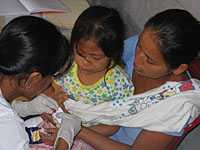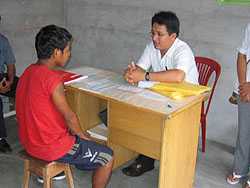CDC Activities in the Amazon Region
Malaria in the Amazon Region
Malaria began to reemerge in the Amazon region of South America in the 1990s, and a number of factors were associated with this increase:
- The migration of large numbers of nonimmune persons into malaria-endemic areas;
- Establishment of highly competent malaria-transmitting mosquitoes, e.g., Anopheles darlingi;
- Climatic fluctuations, such as seen with El Niño;
- Low levels of funding for malaria control programs; and
- Presence of strains of Plasmodium falciparum resistant to chloroquine and sulfadoxine-pyrimethamine.
AMI/RAVREDA Responds to Malaria’s Reemergence
In 2001, eight countries established a surveillance network to address antimalarial drug resistance: the Red Amazónica para la Vigilancia de la Resistencia a las Drogas Antimaláricas (Amazon Network for the Surveillance of Antimalarial Drug Resistance). The U. S. Agency for International Development (USAID) started to provide funding to this network under the Amazon Malaria Initiative (AMI). AMI then expanded and now also covers countries in Central America. CDC has provided technical assistance since the beginning of AMI/RAVREDA.

A young girl in Iquitos, Peru, has a blood smear taken by medical technician to determine if she has malaria. (Courtesy RAVREDA)
AMI/RAVREDA’s stated objectives are to:
- Collect reliable and standardized malaria drug efficacy information in the Amazon region;
- Develop evaluation tools that allow countries to improve their malaria control programs;
- Enhance partnerships to improve malaria control in the Amazon region.
Eleven countries—Belize, Bolivia, Brazil, Colombia, Ecuador, Guatemala, Guyana, Honduras, Nicaragua, Peru, Panama, Suriname, and Venezuela—now make up the network.
Five partners provide technical assistance: CDC, Strengthening Pharmaceutical Management/Management Sciences for Health*, Links Media*, Research Triangle Institute International*, and the United States Pharmacopoeia*.
USAID and PAHO serve as coordinating agencies.
AMI/RAVREDA Accomplishments to Date
- All AMI countries have collected reliable information about the efficacy of their first-line antimalarial treatments.
- All AMI countries have changed their national treatment guidelines to highly efficacious artemisinin-based combination therapy.
- Members have begun regular ongoing insecticide resistance training to support active insecticide resistance surveillance.
- Suriname implemented artemether-lumefantrine (an artemesinin-based combination therapy) as first-line therapy for uncomplicated P. falciparum malaria and then field-tested a protocol to assess patients’ adherence to this drug combination.
- Member countries improved their drug management systems and strategies to evaluate the quality of their drugs.
After initial in vivo efficacy studies were completed and most member countries had changed their antimalarial drug policies, countries began to evaluate other components of their national malaria control programs.

A young boy is interviewed by a health-care worker as part of CDC activities in Iquitos, Peru. Courtesy: RAVREDA
CDC’s Contributions
In AMI/RAVREDA's first few years, CDC provided technical assistance in the areas of antimalarial drug efficacy and effectiveness and mosquito control but has since expanded into other areas:
- Technical assistance with antimalarial drug efficacy studies
- Trained laboratory personnel how to use the bottle bioassay to measure resistance for vector insecticide susceptibility surveillance (VISS)
- Evaluation of mosquito populations
- Supported investigation of entomologic effects of use of insecticide-treated nets (ITNs) in the region using experimental houses
- Evaluation of insecticide-treated mosquito net longevity
- Assistance in conducting antimalarial resistance using molecular methods and also improving personnel capacity in partner countries
- Improvements and training in diagnostic methods and evaluation of gene deletions that could impair the use of malaria rapid diagnostic tests (RDTs)
- Adapted and validated methods for chloroquine and mefloquine analysis in blood using simpler techniques and evaluation of insecticide levels on insecticide-treated bednets using a simple colorimetric method.
- Supported the South-to-South collaboration among partner countries
- Page last reviewed: September 21, 2015
- Page last updated: September 21, 2015
- Content source:


 ShareCompartir
ShareCompartir